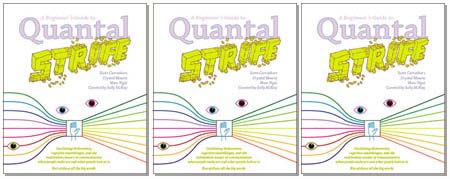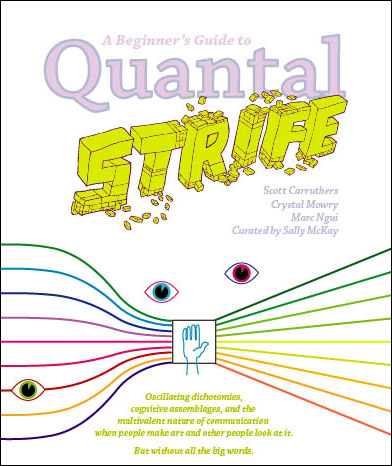
|
Lorna Mills and Sally McKay
Digital Media Tree this blog's archive OVVLvverk Lorna Mills: Artworks / Persona Volare / contact Sally McKay: GIFS / cv and contact |
View current page
...more recent posts

Our Quantal Strife catalogue lauch was really fun last night. Thanks to everyone who came! I have a backlog of tasks piled up now, included a bunch of things for the blog. There will be some more content up here soon, I promise. (I moderated a panel on art and science at the Performance Creation Canada Conference - must report!) In the meantime, brains and beans.

A Beginner's Guide to Quantal Strife
Oscillating dichotomies, cognitive assemblages, and the multivalent nature of communication when people make art and other people look at it.
But without all the big words.
February 7: If you prefer to stay downtown, join us at the Cameron House (480 Queen St. West) on Tuesday, Feb. 7th, at 7 pm for a free party with musical selections by DJ Von Bark...door prizes...free snacks...easy games...suprises...other things...and one very cute little art book/catalogue for sale!
(more details at the Doris McCarthy Gallery website)

Pop quiz: what do the movies Elizabeth, Lost in Translation, and Zoolander have in common?
The current show at InterAccess is really good. Both artists are from Finland, where, according to curator Nina Czegledy, "social awareness, art and technology fuse seamlessly." Well, I don't know much about Finland, but I know what I like! Minna Långström created huge Smurfy blue table and chairs that dwarf the adult viewer and make you feel small. There is also a huge dangling crib toy, twice the size of my head. When you clamber up onto the chair you can blow virtual bubbles with a big orange wand. Inside the bubbles are violent video scenes from the war in Iraq. Pulling the cord on the crib toy triggers the sounds of war. The bubbles were not activating when I was there (apparently some overly interactive art viewer had been underneath the table rearranging cables the day before) and so I am going back for sure before the show closes on February 11th.
Seamless is a good word. The installation, by Jaakko Niemelä is also elegant. [SPOILER ALERT. If you haven't seen the show yet stop reading now.] As you enter the gallery you see a wall sized grid of video feeds. There is a war or insurgence or disaster going on. The cameras flip past emergency vehicles, ladders, flashing lights, tumbled down structures, chasm-like spaces, chaos. The sounds are clipped, harsh and anxious-making — sirens, explosions, gunfire, men making urgent calls and giving directions with the tinny voices of megaphones and walkie talkies. The grid of video is always scrolling, like a security console, the cameras numbered at the bottom of each panel. As you proceed into the space you see around the corner, where a cluster of electronic toy helicopters, tanks, ambulances and fire trucks and emergency vehicles are nestled into a jumble of cables, clutter and spinning cameras, their little toy sounds activated and amplified.
Both pieces were immersive and elaborate but simple in design. And both, for me, invoked the infurating combination of cultural infantilization with dire and violent world events.

Paul Butler's exhibition, Getting There is Half the Fun
Wynick/Tuck Gallery, January 14 to February 1, 2006
reviewed by Valeria Rzianina here
Last weekend I went to a talk about art and time with physicist Lee Smolin and artist Robert Linsley (part of Power Plant's Hubbub series at the Rivoli). Daniel Cockburn's film Metronome was screened as an opening act.
Most physicists carry as many superficial assumptions about contemporary art as most members of the general public (art is for beauty and illustration, abstraction is some kind of elitist gimmick, artists are flighty creatures of imagination that flit about, freely dropping jewels of creative inspiration hither and yon like glittery bird turds decorating the grim grey landscape of hard work and responsibilty that everyone else must endure). Lee Smolin, by contrast, seemed surprisingly interested and conversant with art issues, especially as related to the culture at large. Robert Linsley was up on his physics, and the two had obviously had several good conversations under their belts. As per usual with Hubbub, the talk was unstructured and free ranging, which, in this case, worked out okay.
Here's some of the stuff I'm still thinking about:
There was some discussion of the fact that all our descriptions of time are actually spatial. This observation has come up a few places lately and I don't really get the implications yet.And a couple of notes:
Smolin said that artists imagine their artworks into the future. In this "world which is change", artists produce a "human-made thing that is intended not to change." Smolin said he could not "think of anything else people do with this intention." Like any self-respecting contemporary artist, Linsley poo-pooed this idea of art not-changing over time, claiming that all readings of art are context dependent, etc. Smolin said, well what about Greek Sculpture? And Linsley, after making obvious comments about missing paint, noses and limbs, made the extraordinary statement, "I don't think there is a past in art." He explained himself, conflating temporal and spatial terms, saying that Greek sculptures are "farther away from us," and therefore there are "more mediations we have to go through " to understand them. "All art is present and contemporary," but the universe has expanded, the population of the world has grown, and each individual point of view must be factored into account. There is a now "a greater distance we need to go through" between artifacts — more cultural "mediations." Linsley's conflation of the expanding universe (picture a ballloon with dots on it, etc, etc) with an expanding world population may be an audacious leap, but it makes for an intriguing and unusual cultural model.
Smolin was clearly on a mission to combat postmodern despair. He also decried "nostalgia for the absolute." (In an off-hand comment he cited the mutiple universe theory—which really gets on my tits: "of course there is life on other planets, the number of universes is infinite therefore anything you can imagine does indeed exist..." blah! dumb — as an example of such nostalgia. Yay.) Smolin insisted that there is a third option, an "ever-evolving network of relationships that defines what things are." There is an "increasing complexity in what it means to be a person" an increase in diversity, and an "opening for a hopeful point of view."
Daniel Cockburn's film Metronome had lots of Fight Club reference, including a very clever segue in which Cockburn's drained and driven voice-over melds into Ed Norton's. I related to Fight Club, and I related to Metronome. Cockburn pounds himself repeatedly in the chest, not to injure himself, but to establish a rhythm, continued all day, that becomes a narrative position from which to bear witness on overwhelming contrapuntal beats of footsteps, traffic lights, hollywood movies and, basically, culture, nature and all things of the world. Cockburn's character is uhappily trapped in his linear rhythm, aware of the miasma of related information but unable to escape the metronome and apprehend the full dynamic onslaught of the universe. "Sameness is the enemy of the soul."
Smolin attacked Cockburn's film for mistakenly conceiving of culture as an ordered, oppressive sameness when in fact, according to Smolin, it is a burgeoning myriad of diversity and opportunity. It is much more up-to-date as far as physics goes to think of time as networks of relationships than it is to think of linear tracks. I liked Smolin's attack on despair, and his investment in hopeful futures, but I think he misread the film somewhat. Cockburn was in the audience and opted to defend himself during the question period. Articulate and self-assured he spoke up, "I appreciate your comments. It is rare in this city that anybody says anything publicly negative about a work of art. Howeer, the film is not really about time but about thought." He explained that the film did depict a circular trap, but he was showing a "reverse role model, and not making a 'true' statement aobut the universe." Smolin, a cocky New Yorker with gift of the gab, actually seemed somewhat remorseful, and said that he thought the film was really good, as a film, but that he still felt Cockburn's despairing point of view was off the mark.
Intelligent design came up and Smolin had four extremely interesting things to say. First he said that "society is just begining to digest the implications of Darwinism as slow metaphor of change," and that there "should be skeptics" as the idea is a "wild scheme." Secondly, however, the real question is whether or not natural selection in the "modern framework" including molecular biology and genetics, is "explanatory of everything we know about life." And the answer is yes, "overwhelming evidence and opinion is that the framework of modern biology is fully explanatory." Thirdly, the thing that frightens him most about the American Christian fundamentalist attacks on Darwinisim are not the threat to research — stem cell research can continue in other countries like China — but rather the "splitting of culture into pieces that have less and less to do with each other in a common cultural conversation." And lastly, he suggested that the Chrisitan right has a functional story that is "explanatory and hopeful in the world they want to explain," and prosthelytized that in the scientific and secular world we also need to start telling a story that is explanatory, positive, and hopeful.
There was mention of current work in physics looking into the possibility that the laws of physics may be mutable. Linsley, with his its-all-context agenda was super excited about this, but Smolin reminded him, quite eloquently, that both art and science share the dreadful possibility of failure. "New concepts or questions are hard to implement fully. I might play with the idea that laws evolve but to implement that in the physics I do has so far been impossible." [UPDATE: I removed the quotes around "its all context" above as Robert Linsley has quite rightly pointed out to me that he did not actually say that. All the other quotes in this report are directly from my notes and should be mostly okay...further, I did not mean to give the impression that Linsley was offhand about his position on deconstruction, merely that he was enthusiastic. Further reading here.]
Xtra Note: The only two physicists (besides Smolin) invoked in the discussion were Brian Greene ("string theory is a confusing mess," says Smolin. Hah!) and Julian Barbour. Barbour's book, the end of time, was recommended to me years ago by my friend Chad and is one of the reasons I got into all this damn physics stuff. Barbour irritates physicists because his theory — time is a bunch of overlapping instantaneous moments and our perception of linearity is an illustion based on our physiological constraints— is preposterous, yet plausible enough (and the math works out okay) to warrant debate. I was very interested to hear that Barbour is, according to Smolin, a "philosophical guru" to himself and a number of colleagues.